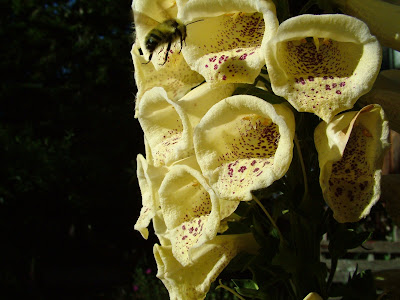
I love foxgloves even though they are not native plants. Each deep-throated foxglove flower stimulates my spirit. The color cascading from each blossom engages my eyes. This photo of a special creamy-white foxglove is the first one with this color to show up in the 25 years I’ve lived here.
While considered an exotic “invader” I like to have it in my garden as a form of controlled chaos. Each year I let the tall flower stalks go to seed and spread their fine, brown seeds where ever they may. This means leaving the flower stalks to mature to an earthy brown. No dead-heading here. No place in my garden for Martha Stewart. These sentinels of future generations remain for weeks until the tiny up-turned cups of the remaining flower parts fill with mature seed and begin to spill with each gust of wind. Sometime I scatter a few seeds myself. (The tallest flower stalks seem to be those growing from seed they have cast asunder, not the seed I plant.)
All this makes for a very kinetic garden as the years go by. One year I had a glorious stand of foxgloves at the end of the main path into my garden. More than two dozen plants reaching four- to six-feet in the air. Each a different shade from hot rose to pale pink to creamy white. The next year they popped up in the soil surrounding the small swale that drains water away from water-sensitive plants on the adjacent berm. This year they have appeared in the soil and mulch left behind after grinding a dead tree stump into oblivion. How they got there, some 20 feet from last years stand, I’ll never know.
The seed needs to fall where there isn’t too much competition. Yet it will grow above some of the grasses. But in the end, it really prefers open soil, my mulched areas or I’ll find clusters of plants will thrive at the edge where mowing meets the more rangy parts of the garden. For the first year the dark-green leaves flourish as they gather the photosynthetic momentum for the flower stalk to thrust skyward. The handful of leaves at the tip of the plant are a pleasure to look at, with a subtle display of the Fibonacci pattern. (The Fibonacci series is the mathematical form portrayed in the cross section of a nautilus shell or the pattern of seeds on a sunflower head.)
Our eyes see delightful beauty in our gardens. Yet, some of the splendor in garden flower remains unseen. Each foxglove blossom has a different set of splotches all the way into its throat, like little runway guides leading to the sweet nectar. These are intriguing enough. But there’s more. Pollinating bumble bees (as seen in the above photo) see something beyond our vision. Bumble bees have a pair of six-sided, compound eyes and three simple eyes. Even with such complex eyes, their sight is accurate for only about three feet. A special light guides bumble bees on their lusty journeys for pure nectar. Bumble bees see ultraviolet light. A pattern of ultraviolet coloration lures a bumble bee into the foxglove flower’s throat. These patterns unseen by our eyes act like the signals of an airport’s landing strip. And the ultraviolet splotches of color don’t match the random splotches we see in the sunshine.
The earth’s protective atmosphere shields us from much of the sun’s ultraviolet light (radiation). Enough ultraviolet radiation filters through to aid bumble bees in their daily journeys. Even on a cloudy day, the bumble bees see the ultraviolet spectrum by cloud-penetrating ultraviolet light. What assists bumble bees on their quest for pollen and nectar can cause us to sunburn—part of the two-sided tapestry of life.
In each blossom the pollen is in the roof of the flower so the upper body of the bumble bee is brushed with the pollen as the bumble bee goes deeper into the blossom to seek out the sweet nectar. After flying to another flower, the pollens are mixed and seed formation begins. The pollination process leads to a plant with a mixture of colors. Yet an isolated stand with creamy flowers will remain shades of cream until a seedling of a rose-colored blossom pops up nearby. Then things get interesting as different blends of color appear.
Foxglove (Digitalis purpurea) is the source of digitalis—a heart medication. According to the American Heart Association: “Digitalis is a drug that strengthens the contraction of the heart muscle, slows the heart rate and helps eliminate fluid from body tissues. It's often used to treat congestive heart failure and is also used to treat certain arrhythmias. Digitalis has been described in medical literature for over 200 years.” The extract is taken from the leaves. (Two synthetic mimics of digitalis are Digitoxin and Digoxin.) India supplies most of the cultivated digitalis. Others sources are wild crafted (gathered from wild, un-cultivated areas) in Europe, from Germany, Switzerland, Hungary and Italy. Digitalis is toxic at very low levels.
Please post a comment - I want to know what you think.
Visit my web site to learn about my other gardening books.
NOTE: The comments section at the bottom of the post has disappeared. Click on the "___ Comments" button or the title under the "Blog Archives". Thanks, Robert
No comments:
Post a Comment